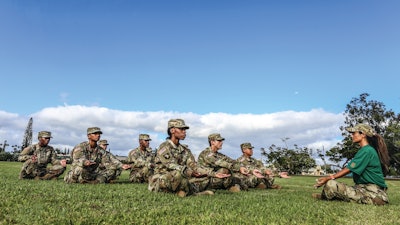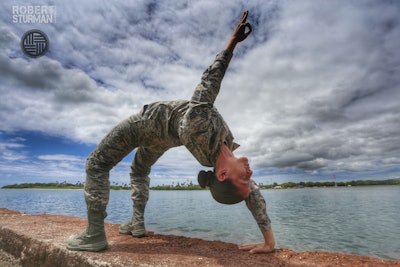![[Photos by Robert Sturman, courtesy of Warriors at Ease]](https://img.athleticbusiness.com/files/base/abmedia/all/image/2021/10/IMG_93411.61795fde9a56d.png?auto=format%2Ccompress&q=70&w=400)
According to a report from the Watson Institute at Brown University, 30,177 active-duty and veteran personnel who engaged in United States military operations since Sept. 11, 2001, have died by suicide, more than four times the 7,057 warriors killed in actual combat.
While the military has always strived to ensure cadets are physically ready for battle, the Department of Defense is starting to embrace a more holistic paradigm in an effort to better help the men and women of the U.S. Armed Forces prepare for the stresses they’ll face during their service, and after it has ended.
Part of that effort includes offering training in nontraditional fitness and wellness modalities such as yoga and mindfulness mediation. In recent years, the DOD has heavily invested in researching the efficacy of these tools, and the results bear out that such activities can have lasting, life-changing benefits for active-duty service members and combat veterans, as well as for soldiers and their families who might never have seen the frontlines of a battlefield. 
Warriors at Ease
One organization that has been instrumental in helping the military bring these types of training to its soldiers is Warriors at Ease, which was founded in 2011 as a nonprofit by Robin Carnes, Karen Soltes, Colonel (ret) Pat Lillis and Molly Birkholm. The four were involved in some of the first clinical studies funded by the DOD and the Department of Veterans Affairs that involved the use of yoga and meditation as adjunct therapies for combat-related health conditions. Warriors at Ease was founded in response to the success of those studies, and the organization has grown rapidly as interest in, and demand for, the program has steadily increased.
“We now have 1,300 teachers in 14 different countries, teaching literally all over the world — in person at Walter Reed, on military bases, community centers, you name it,” says Warrior at Ease executive director Christina Hickey, whose husband is active-duty special operations. “From 2019 to 2020 and into 2021, we’ve really moved from just holding open enrollment trainings to now doing more of a closed enrollment tailored training for the specific locations. So we go in and do a full review of the population, their needs, the current climate, and then we tailor our training protocols to meet the needs of each specific location.”

How that’s done, Hickey concedes, is complicated, but she attempts a pared-down explanation of the process. “Our bodies can only release stress in three different ways — crying, sweating and shaking,” she says. “What we’re doing with these techniques is we’re cultivating what causes crying and sweating and shaking in a very specific way that is going to regulate the nervous system and release physical, mental and emotional stress.”
Along the way, new neural pathways are created, which can promote integration of the left and right brains. Says Hickey, “We actually have sympathetic activation built into our classes so that the brain, or the amygdala, can refile how we’re experiencing stress and how we’re coming down from stress.”
The results of these techniques show true promise.
“In our most recent program evaluation, we had a 68 percent increase in resilience, and a 68 percent decrease in stress,” says Hickey. “We’re also seeing less injuries happen. We’re seeing faster injury recovery. We’re seeing reduced medication use, and overall quality of life is improving.”
From student to teacher
Dan Arnold is an active-duty flight engineer with the Air Force Reserve, as well as a yoga and meditation instructor for Warriors at Ease. He explains that in his current capacity as a flight engineer on a C-130 aircraft, he’s not technically on the frontlines of any battlefield. “We fly into combat zones, but we’re never frontline,” he says. “So even though I say I’m a combat veteran, and I have the ribbons to show I’m a combat veteran, it’s different than our heroes who are getting shot at up close. You know, we may be shot at in our aircraft, but they’re completely different situations.”
Nevertheless, the rigors of being a reservist two weekends a month, while also working a civilian job that requires extensive travel, take a toll on him mentally and physically. Arnold is also a powerlifter and a rugby player, which keeps him active and sometimes involves injuries, which is why he started doing yoga about 15 years ago.
“It helped me stay limber, let me stay semi-healthy,” Arnold says. “As soon as I was healthy enough to go back to the gym, I’d ditch the yoga. I kind of used it as I needed it and then dropped it when I didn’t.”

His relationship with yoga changed when he found Warriors at Ease.
“When I came across the Warriors at Ease group, and being a veteran — especially after more than 15 years in service — you begin to see more and more, especially as you move up in the ranks, the need that people really have,” Arnold reflects. “You begin to see that people are not there as much as they say they are — spiritually, physically, professionally. They’re kind of just hanging on.”
Because of his desire to help others in his military community, Arnold signed up for the Warriors at Ease yoga teacher training in 2018. “Ever since then, I went from getting my yoga certification, to getting certified in iRest [Yoga Nidra] meditation, to body sensing, to all these things that support your nervous system, and your overall mental health and wellness.”
As a teacher, Arnold has seen results, and he believes yoga and meditation are true treatment alternatives to drugs for everything from mental health issues to pain management. “It’s kind of like it is a drug, because I know the benefits,” he says. “Luckily, I’ve never been hooked on any opioids or any medications for the pain I have, but there are a lot of people who are hooked on that kind of stuff. And that’s their lives, and they’re just destroying their lives. This stuff is evidenced based. It’s proven to work.”
Removing the ‘woo-woo’
One complication of bringing these practices to the military community is that yoga and meditation are rooted in spiritual traditions. As such, soldiers come to these practices with a lot of preconceived notions, and in many cases, some resistance.
“We call it the ‘fluff’ or the ‘woo-woo,’ and we strip it down to the basics,” Hickey says. “We’re going to breathe, and we’re going to move. The language of yoga is Sanskrit. Our teachers are not allowed to use Sanskrit. They have to dress in a particular way. They have to introduce the practice in a very particular way. So we create accessibility, whereas a traditional yoga class with a traditional yoga teacher wasn’t really accessible to the military community, because they didn’t understand it.”
Arnold agrees that this is an important part of introducing these techniques to troops. “If we take away all of the hippie-ish stuff that people really don’t want to see — especially these military guys who are like, ‘I’m not doing all that hippie crap, I’m a man, I’m a warrior’ — it’s like we can take this and implement it, and make this an effective tool for people to use.”

Arnold says his first experience with iRest mediation at a Yellow Ribbon event — a pre- and post-deployment event — was underwhelming, and he didn’t think much of it. However, his second experience proved transformative.
“I went to a training that was done by a Warrior at Ease instructor,” Arnold recalls. “She put me down. In minutes, I was out. I was asleep. I woke up, and I was heavy, and I was like what just happened? How did this even happen? I felt like I was kind of hypnotized. What you’re doing is letting your body rest. Your body is saying, I’m just going to relax. Your body is saying, I can just sleep. I can be normal. A lot of people are not used to this, so when you come back it’s kind of a heavy feeling.”
Some might ask — and certainly the military did before it embraced these techniques — whether skills rooted in pacifist ideologies would perhaps dull a soldier’s edge. Hickey says that couldn’t be further from the truth.
“We call it sharpening the warrior,” she says. “When you’re constantly on alert, you have an IV drip of the stress hormone cortisol. So you never actually go into what’s called rest or digest. So what happens when you go into rest or digest is you have cellular regeneration. It’s where you’re going to get stronger. It’s where memories are going to file. It’s where you’re going to create stronger neural pathways. It’s where your muscles are going to repair themselves. So you’re actually going to be a better shooter, a better leader, and you’re going to be a better warrior by practicing these things.”
The work that Warriors at Ease is doing appears to be gaining more official traction within the military itself. In February 2021, the Army began a 10-week pilot program with soldiers in 20 basic training platoons at Fort Jackson, S.C. The trial hopes to evaluate whether daily practice of yoga and meditation will positively impact mental toughness, soldier discipline, injury mitigation, stress management and even graduation rates. Early results were promising, revealing better pain management and faster recovery times.
For the time being, Arnold and others like him within Warriors at Ease will continue to do what they’re doing, bringing these new tools to soldiers, veterans and their families.
Says Arnold, “The more we integrate this stuff and assure people that we’re not going to make you fold up like a pretzel, the more we just sit here and focus on our breathing, the more and more people will buy into it, because they’re going to be like, ‘Wow, this really works!’ ”
The views expressed and photos of military personnel presented in this publication are entirely those of the author and those interviewed and do not necessarily reflect the views, policy or position of the United States Government or the U.S. Department of Defense.





































